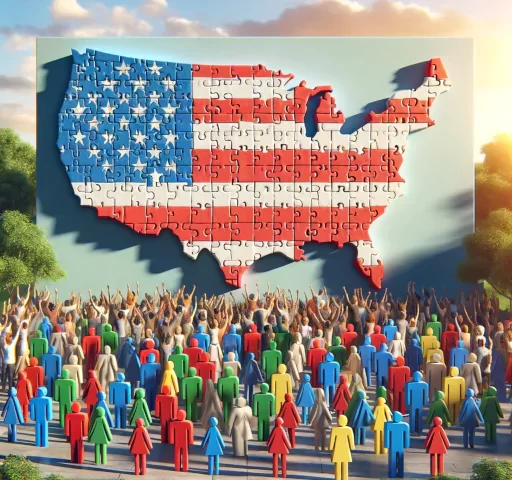NVRA For Short
The National Voter Registration Act of 1993, also known as the NVRA or the “Motor Voter Act,” is a United States federal law that was enacted to enhance voting opportunities for every American. The Act has several key provisions designed to make it easier for all eligible citizens to register to vote and to maintain their registration.
Key Takeaways:
- The Act made voter registration easier by allowing registration at DMVs and via mail, aiming to increase voter participation.
- It addressed low voter registration and turnout, inconsistency in registration processes across states, and the need for standardization and accessibility.
- Despite criticisms about the potential for fraud and implementation challenges, the Act significantly improved access to voter registration, contributing to a more inclusive democratic process.
What is the NVRA?
The NVRA, also known as the National Voter Registration Act of 1993 or the “motor voter law,” outlines requirements for voter registration in federal elections.
Table of Contents
- What does Section 5 of the NVRA entail?
- What does Section 6 of the NVRA require?
- What are the obligations under Section 7 of the NVRA?
- What does Section 8 of the NVRA address?
- Why is it important to register to vote?
- The Essentials of Voter Registration Act of 1993
- Why was this needed: The National Voter Registration Act of 1993?
- Why is it Important to Register to Vote?
- The Heavy Hitters: Key Players in its Enactment
- The "Why" Factor: Reasons Behind the Voter Registration Act of 1993 Creation
- Diving Deeper: Understanding the Provisions of the Voter Registration Act of 1993
- Hopping on Board: How State Governments Took Up the Mantle
- Voter Registration Act of 1993: Reducing Disenfranchisement in a Big Way
- Numbers Don't Lie: The Power of Participation
- Ripple Effects: Setting Dominoes into Motion
- Critics Corner: Not All Roses and Sunshine
- State Autopsies: Extracting Lessons from Implementations
- Did You Know? Fascinating Nuggets about the Act
- Not Just for Drivers
- Revealing Hidden Facets: Behind-the-Scenes Drama During its Enactment
- Battle of Interpretations
- Not All Sunshine and Roses
- Navigating Potential Changes: Amendments and Improvements
- A New Dawn – Emerging Trends Influencing Future Directions
- Hitting the Mark: The NVRA and Today's Political Climate
- Democracy's Champion: The Role of NVRA in Shaping Participation
- Does Voter Registration Expire?
- Putting Pen To Paper: Final Thoughts
What does Section 5 of the NVRA entail?
Section 5 mandates that States must provide voter registration services at their motor vehicle agencies.
What does Section 6 of the NVRA require?
Section 6 stipulates that States must offer voter registration through mail-in applications.
What are the obligations under Section 7 of the NVRA?
Section 7 dictates that States must offer voter registration services at certain State and local offices, including those related to public assistance and disability.
What does Section 8 of the NVRA address?
Section 8 outlines requirements for States regarding the management of voter registration, including the implementation of procedures to maintain accurate and current voter registration.
Why is it important to register to vote?
- Democratic Participation: Voting is a fundamental democratic right and a cornerstone of most democratic societies. By registering to vote, you gain the ability to participate in the decision-making process that shapes your government and its policies.
- Representation: Voting ensures that your voice is heard in the political process. It allows you to have a say in choosing representatives who align with your views and interests. These representatives make decisions on a wide range of issues, from education and healthcare to infrastructure and national security.
- Influence Policy: Elected officials are more likely to consider the needs and wants of those who vote. By voting, you can influence public policy and the allocation of resources in your community.
- Community Impact: Local elections, often less publicized than national ones, can have a significant impact on your community. They determine local leaders and decisions on local school boards, municipal policies, and public services, which directly affect your daily life.
- Civic Duty: Voting is not just a right but also a civic responsibility. By participating in elections, you contribute to the health and sustainability of the democratic process.
- Change and Progress: Voting can lead to change and progress in society. Historically, voting has been essential for civil rights, gender equality, and social reforms. It remains a powerful tool for advocating for change and improving society.
- Setting an Example: Registering to vote and participating in elections sets a positive example for others in your community, encouraging them to engage in the democratic process as well.
- Staying Informed: The process of registering to vote and preparing to vote often leads to becoming more informed about political issues and candidates, fostering a more educated and aware electorate.
Registering to vote is important not only as a right but as a vital part of participating in and shaping the society in which you live.
The Essentials of Voter Registration Act of 1993
In essence, NVRA streamlined voter registration processes across multiple states in America. It mandated state governments to offer voter registration opportunities at DMVs (Department of Motor Vehicles) and other public assistance offices.
Imagine you’re renewing your driver’s license and you can simultaneously register to vote. It’s an act that intertwines routine procedures with crucial civic duties, creating a seamless integration between citizen life and political participation.
Another critical provision within the act was regarding mail-in registrations. Pre-NVRA, many states did not permit this mode of enrollment; however, under NVRA guidelines, all states were required to accept and process mail-in registration forms which made participation accessible even from one’s home.
The National Voter Registration Act of 1993 (NVRA), commonly referred to as the “Motor Voter Act,” was enacted to address several key issues in the voter registration process in the United States. Its necessity stemmed from a desire to make voter registration more accessible, increase voter participation, and maintain accurate voter registration rolls. The reasons for its implementation include:
Why was this needed: The National Voter Registration Act of 1993?
- Low Voter Registration and Turnout: Before the NVRA, the United States had a problem with low voter registration and turnout rates. The process of registering to vote was seen as cumbersome and a barrier to participation for many eligible voters.
- Inconsistent Registration Processes: Before the NVRA, voter registration processes varied widely across states and often involved complicated procedures. This inconsistency led to unequal access to voter registration, depending on where a person lived.
- Need for Standardization and Accessibility: The NVRA aimed to standardize voter registration processes across states and make registration more accessible to all eligible voters. By requiring states to offer voter registration opportunities at motor vehicle departments (hence “Motor Voter”), as well as public assistance and disability offices, the Act sought to integrate voter registration into everyday activities.
- Encouraging Participation Among Underrepresented Groups: The Act was particularly focused on increasing registration among underrepresented and marginalized groups, including low-income and disabled individuals, who might not interact frequently with traditional voter registration sites.
- Updating Voter Registration Rolls: The NVRA also set forth guidelines for how states should maintain their voter registration lists, including provisions for removing the names of deceased individuals and those who moved out of state, thereby aiming to keep voter rolls accurate and up-to-date.
- Political Response to Public Demand: The NVRA was also a political response to public demand for reform in the electoral process. It reflected a broader movement towards making democratic participation more inclusive and straightforward.
In essence, the National Voter Registration Act of 1993 was a significant step toward making the electoral process in the United States more accessible and equitable, addressing historical challenges in voter registration and ensuring that more citizens had the opportunity to exercise their right to vote.
Why is it Important to Register to Vote?
Registering to vote is fundamental to participating in democratic processes. It’s the first and most essential step in exercising one’s right to vote, which is a cornerstone of democracy. The importance of voter registration can be broken down into several key points:
- Exercising Your Right: Voting is a fundamental democratic right in many countries, and registering is how you claim that right. It’s a way to make your voice heard on important issues and in choosing leaders who will make decisions that impact daily life.
- Influencing Government Policies: By voting, you have a say in shaping policies and decisions that affect various aspects of life, from healthcare and education to infrastructure and environmental protection. Elected officials are more likely to consider the needs and wants of their voting constituents.
- Community Representation: Voting ensures that diverse communities and interests are represented in government. When more people participate in elections, the elected government is more reflective and inclusive of the population it serves.
- Civic Responsibility: Registering to vote and participating in elections is a civic duty. It’s part of being an active and engaged member of society and contributing to its direction and stability.
- Impact on Local, State, and National Issues: Voting doesn’t just influence national politics; it’s also crucial for local and state issues, where decisions can have a direct and immediate impact on your community.
- Setting an Example: By registering and voting, you set a positive example for others in your community, especially young people or those new to the voting process, encouraging a culture of participation.
- Addressing Voter Apathy and Disenfranchisement: High voter registration and turnout can combat voter apathy and make it harder for any group to be systematically disenfranchised.
- Eligibility for Jury Duty: In many places, voter registration lists are used to select citizens for jury duty, an important component of the judicial system.
Registering to vote is more than just a bureaucratic step; it’s an empowering action that enables individuals to influence their governments, contribute to society, and uphold democratic values.
The Heavy Hitters: Key Players in its Enactment
Behind every significant legislative change are visionaries who see beyond the status quo. For NVRA, these were the likes of Senators:
Wendell Ford
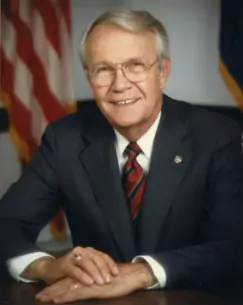
Wendell Hampton Ford
Governor Kentucky (1971-74), Senator (1974-1999)
Daviess County
Mark Hatfield
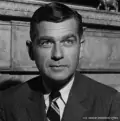
After serving two terms as governor of Oregon, Hatfield was elected to the U.S. Senate as an anti-war candidate. After leaving the Senate, Hatfield resumed teaching political science as well as history. Hatfield died August 7, 2011
and House Representatives
Al Swift

Party Democratic House Washington, District 2 96th-103rd (1979-1995)
John Lewis
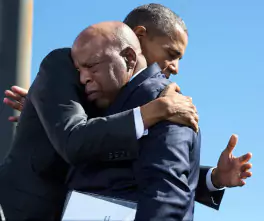
In 1961, while participating in the Freedom Rides that challenged the segregation of Southern interstate bus terminals, Lewis was beaten and arrested—experiences he would repeat often.
bipartisan leaders who championed the bill’s passage. The journey to its enactment was not devoid of resistance.
However,
President Bill Clinton’s
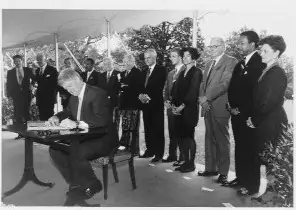
President Bill Clinton signed the National Voter Registration Act of 1993 (Motor Voter Act), as Vice-President Albert Gore and notable members of Congress looked on
steadfast support was instrumental in overcoming hurdles. Upon signing the act into law on May 20, 1993, he noted that it would
Finally Tear Down The Last Barriers to Citizens’ Rights to Vote.President Bill Clinton
The “Why” Factor: Reasons Behind the Voter Registration Act of 1993 Creation
The rationale behind NVRA’s birth stems from a fundamental democratic ethos—equal access to voting rights for all eligible citizens. Before NVRA, voter registration processes varied widely among states with many being restrictive or convoluted—preventing certain demographics from political participation.
Another key reason was to combat declining voter turnout rates which threatened the vibrancy of American democracy. By making registration processes more straightforward and accessible, it aimed to enable more citizens’ involvement in shaping the nation’s course—breathing new life into America’s democratic soul.
Diving Deeper: Understanding the Provisions of the Voter Registration Act of 1993
One might wonder, why all the fuss about making voter registration simpler. Well, it turns out this was one of the primary objectives for the implementation of the National Voter Registration Act in 1993.
The idea was to eliminate as many obstacles to voting as possible. The government realized that cumbersome voter registration procedures were putting people off from participating in elections – not an ideal situation for a democratic nation.
The Act sought to make voter registration as simple as updating your driver’s license at a local Department of Motor Vehicles (DMV). Quite literally, in fact!
This provision is often referred to as “Motor Voter” because it allows citizens to register to vote or update their information when they apply for or renew their driver’s licenses. This step made significant strides toward making voting more accessible and less intimidating for millions.
Another innovative provision included offering voter registration opportunities at public assistance offices and agencies providing services to people with disabilities. These steps made voting even more accessible, bringing it within reach for those who may have once been marginalized or overlooked completely.
Hopping on Board: How State Governments Took Up the Mantle
The NVRA wasn’t just about federal mandates; it also involved states rolling up their sleeves and getting down to work. Each state was required by law to create and maintain accurate and current voter registration rolls for elections.
This job fell primarily on state motor vehicle agencies, but public assistance offices had roles too. This act sparked much-needed collaboration between federal entities and state governments.
Suddenly, different branches were working together in unprecedented ways — all intending to enhance democratic participation across all states and territories. In addition to this, states were asked to allow mail-in voter registration.
On the surface, it may seem like a small change, but in reality, it was a game-changer. It eliminated the need for citizens to physically go somewhere to register to vote — making the process far less daunting and more convenient.
Voter Registration Act of 1993: Reducing Disenfranchisement in a Big Way
Disenfranchisement is a word that sends chills down any democracy lover’s spine. The NVRA helped combat this issue head-on by expanding opportunities for voter registration. In an unprecedented shift in policy, the NVRA limited states’ ability to remove registered voters from their lists.
Of course, there were exceptions – if individuals moved out of their jurisdiction or had passed away. But for circumstances other than these two exceptions, states could not just purge their voter rolls indiscriminately.
The Act also set down provisions stating that if voters failed to vote even after being inactive over a couple of election cycles, they could not be removed from the list either. These steps ensured that once you’re on the roll and eligible, you get your chance to vote without any unnecessary hurdles or red tape standing between you and your fundamental democratic right.
Numbers Don’t Lie: The Power of Participation
There is a remarkable truth in the adage, numbers don’t lie. After the enactment of the National Voter Registration Act (NVRA), there was a marked surge in voter registrations.
The U.S. Census Bureau attests to this fact – approximately 87.5 percent of registered voters turned out to vote in the 1996 elections, just three years post-NVRA implementation; a noteworthy increase from preceding years. However, more than just boosting voter turnout, the NVRA opened doors for broader citizen participation.
It became easier for individuals across various socioeconomic strata to register and vote – especially those who were previously underrepresented owing to logistical inconveniences or lack of information about registration processes. Yet, even though numbers underscore success, it’s important to bear in mind that they only represent part of the story – behind each statistic lies a tapestry of individual experiences and narratives engendered by this legislation.
Ripple Effects: Setting Dominoes into Motion
The impact of NVRA extended beyond simply increasing voter registration rates – it catalyzed change across multiple facets of electoral laws and policies too. One significant ripple effect was how it encouraged states to update their voting systems regularly, expediting their transition toward electronic systems. In addition, it spurred other legislative reforms aimed at making voting more accessible — including initiatives like early voting and mail-in ballots — thus continuing its legacy by indirectly shaping other policies around democratic engagement.
What’s more, some states used NVRA as an impetus for further innovation; they began considering online registrations and automatic enrollment options for citizens. Though these advances weren’t directly stipulated by NVRA, their roots can be traced back to its central ethos – simplifying registration procedures to promote wider involvement in democratic processes.
Critics Corner: Not All Roses and Sunshine
As with any major legislation, NVRA faced its share of criticism and controversy. Detractors argued that while the Act did simplify registration, it lacked the teeth to enforce these provisions effectively.
They contended that in some cases, state agencies were slow or even reluctant to implement the necessary changes. Another bone of contention was potential voter fraud.
With easier registration came concerns about maintaining the integrity of voter lists. Skeptics felt that NVRA might inadvertently open floodgates for fraudulent practices by making it too easy for individuals to register and vote multiple times using false identities.
There was apprehension about whether NVRA would truly facilitate equitable access to voting: could simplification alone ensure inclusion? Critics pointed out there are more entrenched barriers — such as literacy levels, language barriers, or civic knowledge — which this Act did not directly address.
State Autopsies: Extracting Lessons from Implementations
The varied impact of NVRA across states serves as a treasure trove of lessons for future policy implementation. One key takeaway is that mere legislation isn’t sufficient; active promotion and awareness are critical catalysts in driving successful outcomes. Georgia stands testament to this fact.
Another interesting lesson emerges from contrasting experiences like those between Oregon and Illinois initially post-NVRA enactment. While both states launched programs aligned with NVRA provisions – motor voter programs for instance – Oregon’s experience underlines how continuous innovation can significantly enhance policy effectiveness.
State-specific factors play an undeniable role in shaping policy impact. Socio-economic factors, geography, population density – all these can influence the reach and effectiveness of policies like NVRA.
That’s food for thought as we consider future policy agendas and initiatives. It seems apparent that NVRA’s story is one that’s still being written.
States continue to grapple with its implementation and innovate ways to increase voter registration. Whether they succeed or not, the lessons are there for all to see, learn from, and react accordingly.
Did You Know? Fascinating Nuggets about the Act
A Bill by Any Other Name…
Did you know that informally, the National Voter Registration Act of 1993 is often referred to as the “Motor Voter” Act? The moniker results from one of its most impactful provisions – allowing individuals to register to vote while they renew or apply for a driver’s license. This element caused ripples throughout society, making voter registration accessible in an unprecedented way, and coining a catchy nickname.
Not Just for Drivers
Another interesting tidbit is that despite its popular name, states are also required to offer voter registration opportunities at all state-run offices providing public assistance. These include offices for disability services and military recruitment centers.
Even unemployment offices are roped in! This allows for a more comprehensive reach into diverse populations, ensuring democracy isn’t just available at your DMV.
Revealing Hidden Facets: Behind-the-Scenes Drama During its Enactment
Behind every significant legislation lies copious debate and drama. The NVRA was no different.
It was intended to be enacted sooner – under President George Bush’s reign; however, after passing through Congress twice, it was vetoed both times by him. A surprising twist came with President Clinton’s election, who promptly signed it into law within his first few months.
Battle of Interpretations
The NVRA became a bone of contention among states, leading to various interpretations and implementations that often ended up in court. The Act stirred the pot, igniting fervent discussion about the federal and state power dynamics. States like California and Illinois were taken to court by the Department of Justice over disagreements in its interpretation.
Not All Sunshine and Roses
Passing any legislation is a roller coaster ride filled with highs and lows. The NVRA faced intense opposition, primarily from those who believed it would lead to increased voter fraud or those who saw it as an unfunded mandate.
Despite these obstacles, its impact has been largely positive. These hidden dramas and facts create a vibrant tapestry that tells the tale of this game-changing Act.
Navigating Potential Changes: Amendments and Improvements
Grasping the fluctuating dynamics of civic legislation requires anticipatory foresight. It’s as if we’re navigating a vast ocean, where the winds of societal needs and political will determine our course. One wonders what amendments and improvements might be on the horizon for the NVRA.
Though robust, it’s not impervious to change or immune to critique. Certain quarters have suggested that introducing a provision for automatic voter registration could significantly enhance NVRA’s effectiveness.
Imagine a system where each eligible citizen is automatically registered when interacting with governmental bodies like DMVs unless they choose to opt out! This could potentially escalate our democratic participation to new heights.
Beyond this, there’s also talk about modernizing voter registration by allowing online registrations nationally – an upgrade well overdue in our digital era. A more inclusive dialogue regarding felon disenfranchisement is also being pushed onto legislative tables with renewed vigor, demanding amendments that counteract voter suppression.
A New Dawn – Emerging Trends Influencing Future Directions
In this rapidly changing world where trends shift as quickly as tectonic plates, one can’t help but wonder how emerging tendencies will shape the future trajectory of NVRA. An interesting phenomenon unfolding before us is the increasing utilization of technology in election processes. Blockchain technology is making waves in the electoral landscape by promising secure, incorruptible voting systems which may well revolutionize how we register voters and conduct elections.
These technological advancements are likely to impact current laws like NVRA and signal significant modifications ahead. Additionally, a stronger push towards inclusivity is discernible on our socio-political horizons.
Calls for expanding voting rights to marginalized communities through reforms in existing laws like NVRA are gaining momentum. In the coming years, it will be fascinating to observe how these emerging trends reshape our electoral canvas and redefine the parameters of the NVRA.
Hitting the Mark: The NVRA and Today’s Political Climate
The National Voter Registration Act of 1993 (NVRA), often referred to as the “Motor Voter Act”, is not just a relic of the past. It continues to play a vital role in our political world today, and its importance cannot be overstated. In a time where our political climate seems more polarized than ever, the NVRA stands as a bastion of democracy, facilitating and encouraging voter participation.
Despite its enactment nearly three decades ago, the NVRA remains exceptionally relevant today, serving as a crucial instrument in countering voter suppression efforts. In an era where certain factions constantly challenge voting rights, this act shines through as an optimistic countermeasure, ensuring that accessibility remains at the forefront of the registration process.
By simplifying registration procedures and making it more accessible for all citizens irrespective of socioeconomic status or geographical location, it ensures democracy is not just a privilege but a right exercised by all. The NVRA continues to evolve with time.
With technological advancements paving the way for potential online voter registration systems across all states, its relevance only looks set to increase going forward. Through such progressive amendments keeping pace with modern technology trends, it further emphasizes how intertwined this Act is with our current political landscape.
Democracy’s Champion: The Role of NVRA in Shaping Participation
The National Voter Registration Act has been instrumental in shaping democratic participation across America since its inception by expanding access to voting opportunities. By removing administrative barriers previously stifling this process, it has been successful in broadening the democratic space for citizen engagement and participation. It has been particularly impactful on marginalized communities who were previously disenfranchised due to complex registration processes or restrictive legislation.
By facilitating easier access to voter registration while dealing with state motor vehicles or social service agencies, it has ensured that the right to vote is not determined by how much one earns or where one lives. Rather, it reinforces the idea that every voice matters and that each individual’s vote can contribute to shaping the nation’s future.
The NVRA has even prompted a cultural shift in how we perceive voting. No longer a privilege tied with societal status or wealth, it transformed voting into a commonplace civic duty accessible to all — injecting fresh vibrancy into our democratic system and fostering an environment of active political participation.
Does Voter Registration Expire?
Voter registration typically does not expire in the United States. However, there are some circumstances where your registration might be canceled or marked inactive, which can affect your ability to vote. These circumstances include:
- Moving to a New Address: If you move, especially to a new county or state, you’ll likely need to re-register to vote. Your registration does not automatically move with you.
- Not Voting for Several Years: In some states, if you haven’t voted in several years, you may be placed on an “inactive” list. If you remain inactive for an additional period (often including missing one or two federal election cycles), your registration can be canceled.
- Registration Errors or Inaccuracies: If your registration contains errors or outdated information, it may need to be updated. This can include changes in name, address, or other personal information.
- State-Specific Policies: Some states have specific rules or policies that might lead to a cancellation of your registration, such as “purge” laws that remove voters from the rolls under certain conditions.
It’s a good practice to check your voter registration status regularly, especially before an election, to ensure that your information is up-to-date and you are eligible to vote. Most states have online tools that allow you to check your registration status easily.
Putting Pen To Paper: Final Thoughts
The National Voter Registration Act of 1993 stands as a beacon of democratic progress. It serves as a reminder to us all about the importance of exercising our right to vote, and how necessary accessible registration is for ensuring fair representation.
Despite challenges and opposition throughout its existence, NVRA has continued to stand tall, proving its relevance and resilience time after time. In an era where democracy is often under threat, remembering acts like these helps reinforce optimism for our future — shining light on the fact that determination and commitment can indeed bring about profound positive changes.

